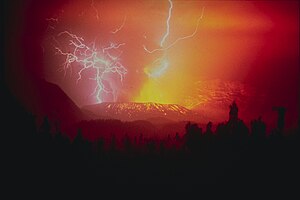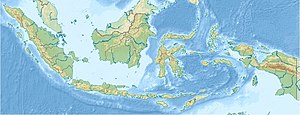Galunggung
| Galunggung | ||
|---|---|---|
|
Dirty thunderstorm at Galunggung on December 3, 1982 |
||
| height | 2168 m | |
| location | Java ( Indonesia ) | |
| Coordinates | 7 ° 15 '23 " S , 108 ° 4' 33" O | |
|
|
||
| Type | Stratovolcano | |
| Last eruption | 1984 | |
The Gunung Galunggung ( Indonesian Gunung "mountain") is an active volcano on the Indonesian island of Java . It is 40 kilometers east-northeast of the Papandayan and 16 kilometers northwest of the city of Tasikmalaya with more than 700,000 inhabitants, for whom it is a direct danger.
The mountain has only three flanks, as its entire southeast side collapsed, creating a large caldera-like basin that channels eruption outflows naturally. Below the demolition area, the so-called Ten Thousand Hills of Tasikmalaya , countless small elevations above the grassland , extend in the plain . Most of them are built up because in earlier times they offered good protection against enemies and are located above the rice fields with their rats and mosquitoes . This landscape attracted the interest of geo- and volcanologists at the beginning of the 20th century . At first it was assumed for a long time that the hills were formed or artificially built by lahars or water outflows from the crater. After the eruption of Mount St. Helens in 1980 and investigations into the demolitions on Mount Shasta , it became clear that Gunung Galunggung must also be the remains of a debris avalanche - most likely that of the south-eastern slope. A radiocarbon dating of lava revealed the collapse that in the last 23,000 years, probably before 4200 years, must have happened.
Only five historical eruptions of the volcano are recorded. The first, which was also the most intense and devastating, dates back to 1822. The eruption, which began on October 8 and is recorded on the Volcanic Explosion Index (VEI) with strength 5, killed 4011 people. In the course of the eruption, lava flows, lahars, pyroclastic flows up to ten kilometers long , and a cloud of embers destroyed 114 villages in the area. Another eruption followed in 1894, and in 1918 a large lava dome formed on the summit .
On April 5, 1982 the last eruptive phase of Gunung Galunggung began, which was recorded on the VEI with a strength of 4. It lasted nine months and can be divided into three sections. Initially, up to six kilometers high ash clouds formed over the summit by mid-May, while streams of slag up to five kilometers long flowed down the slopes. From mid-May to October there were then numerous strong phreatomagmatic explosions , which destroyed 80 percent of the lava dome that was built in 1918 and resulted in ash columns up to 24 kilometers high. Ash rain fell within a radius of 90 kilometers around the mountain. In addition, an average 780 meters wide and 300 meters deep crater formed in the southwestern demolition at an altitude of 1090 meters .
On June 24, one fell Boeing 747-200 of British Airways Flight 9 in an ash cloud. All four engines failed and the aircraft sank from 11,300 to 4,100 meters in 16 minutes. After the gliding flight, the engines started again and you could make an emergency landing in Jakarta . The following months from November to January 8, 1983 were characterized by a slight discharge of lava from the crater and the formation of a small ash cone within the crater. The cone reached a height of 75 and a width of 200 meters. The eruption from 1982 to 1983 claimed 68 lives, the majority of whom died not directly from volcanic activity but from shocks , hypothermia, malnutrition and traffic accidents during the evacuation . A total of 62,000 residents were asked to do this. 22 villages were destroyed or uninhabitable, 94,000 hectares of agricultural land were devastated, the material damage amounted to 15,000,000 US dollars .
After a year of rest, there was renewed activity in 1984 in the form of two-week phreatic eruptions .
Web links
- Galunggung in the Global Volcanism Program of the Smithsonian Institution (English)
Individual evidence
- ↑ Mauro Rosi, Paolo Papale, Luca Lupi, Marco Stoppato: Volcanoes (= Firefly guide ). Firefly Books, Buffalo 2003, ISBN 1-55297-683-1 , pp. 176 (English, 335 p., Limited preview in Google Book search).


